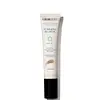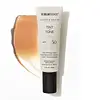What's inside
What's inside
 Key Ingredients
Key Ingredients

 Benefits
Benefits

 Concerns
Concerns

 Ingredients Side-by-side
Ingredients Side-by-side

Titanium Dioxide 2.1%
Cosmetic ColorantZinc Oxide 17%
Cosmetic ColorantDimethicone
EmollientCaprylic/Capric Triglyceride
MaskingDimethicone Crosspolymer
Emulsion StabilisingDimethicone/Vinyl Dimethicone Crosspolymer
Skin ConditioningButyloctyl Salicylate
Skin ConditioningGlyceryl Isostearate
EmollientPolysilicone-15
UV FilterNiacinamide
SmoothingCaffeine
Skin ConditioningUbiquinone
AntioxidantTetrahexyldecyl Ascorbate
AntioxidantTocopheryl Acetate
AntioxidantSqualane
EmollientPunica Granatum Extract
AstringentVaccinium Macrocarpon Fruit Extract
AstringentCamellia Sinensis Leaf Extract
AntimicrobialSilica
AbrasivePEG/PPG-18/18 Dimethicone
EmulsifyingPolyhydroxystearic Acid
EmulsifyingTriethoxycaprylylsilane
Iron Oxides
Titanium Dioxide 2.1%, Zinc Oxide 17%, Dimethicone, Caprylic/Capric Triglyceride, Dimethicone Crosspolymer, Dimethicone/Vinyl Dimethicone Crosspolymer, Butyloctyl Salicylate, Glyceryl Isostearate, Polysilicone-15, Niacinamide, Caffeine, Ubiquinone, Tetrahexyldecyl Ascorbate, Tocopheryl Acetate, Squalane, Punica Granatum Extract, Vaccinium Macrocarpon Fruit Extract, Camellia Sinensis Leaf Extract, Silica, PEG/PPG-18/18 Dimethicone, Polyhydroxystearic Acid, Triethoxycaprylylsilane, Iron Oxides
Butyl Methoxydibenzoylmethane 3%
UV AbsorberOctocrylene 2.75%
UV AbsorberEthylhexyl Salicylate 5%
UV AbsorberWater
Skin ConditioningButyloctyl Salicylate
Skin ConditioningGlycerin
HumectantHelianthus Annuus Seed Oil
EmollientDimethicone
EmollientMica
Cosmetic ColorantZea Mays Oil
EmulsifyingPolyester-8
Skin ConditioningCoco-Caprylate/Caprate
EmollientPolysilicone-15
UV FilterSodium Stearoyl Glutamate
CleansingSodium Hyaluronate
HumectantPanthenol
Skin ConditioningCeramide NP
Skin ConditioningCeramide AP
Skin ConditioningCeramide EOP
Skin ConditioningPhytosphingosine
Skin ConditioningCaffeine
Skin ConditioningSodium Ascorbyl Phosphate
AntioxidantNiacinamide
SmoothingVitis Vinifera Callus Culture Extract
Camellia Sinensis Leaf Extract
AntimicrobialAloe Barbadensis Leaf Extract
EmollientProline
Skin ConditioningAllantoin
Skin ConditioningChamomilla Recutita Extract
Skin ConditioningTremella Fuciformis Extract
HumectantMacadamia Integrifolia Seed Oil
Skin ConditioningOlea Europaea Fruit Oil
MaskingRosa Moschata Seed Oil
EmollientLavandula Angustifolia Oil
MaskingDiatomaceous Earth
AbrasiveLaminaria Digitata Extract
Skin ProtectingSesamum Indicum Seed Oil
EmollientRosmarinus Officinalis Leaf Extract
AntimicrobialFerric Hexapeptide-35
Skin ConditioningMelaleuca Alternifolia Leaf Oil
AntioxidantCaprylic/Capric Triglyceride
MaskingCaprylyl Glycol
EmollientSodium Polyacrylate
AbsorbentTeprenone
Skin ConditioningLecithin
EmollientSorbitol
HumectantAcrylates/C10-30 Alkyl Acrylate Crosspolymer
Emulsion StabilisingCaprylhydroxamic Acid
Cholesterol
EmollientXanthan Gum
EmulsifyingCarbomer
Emulsion StabilisingSodium Hydroxide
BufferingTbhq
AntioxidantPhenylpropanol
MaskingSodium Lauroyl Lactylate
EmulsifyingSynthetic Fluorphlogopite
Tin Oxide
AbrasiveCI 77891
Cosmetic ColorantCI 77499
Cosmetic ColorantCI 77492
Cosmetic ColorantCI 77491
Cosmetic ColorantButyl Methoxydibenzoylmethane 3%, Octocrylene 2.75%, Ethylhexyl Salicylate 5%, Water, Butyloctyl Salicylate, Glycerin, Helianthus Annuus Seed Oil, Dimethicone, Mica, Zea Mays Oil, Polyester-8, Coco-Caprylate/Caprate, Polysilicone-15, Sodium Stearoyl Glutamate, Sodium Hyaluronate, Panthenol, Ceramide NP, Ceramide AP, Ceramide EOP, Phytosphingosine, Caffeine, Sodium Ascorbyl Phosphate, Niacinamide, Vitis Vinifera Callus Culture Extract, Camellia Sinensis Leaf Extract, Aloe Barbadensis Leaf Extract, Proline, Allantoin, Chamomilla Recutita Extract, Tremella Fuciformis Extract, Macadamia Integrifolia Seed Oil, Olea Europaea Fruit Oil, Rosa Moschata Seed Oil, Lavandula Angustifolia Oil, Diatomaceous Earth, Laminaria Digitata Extract, Sesamum Indicum Seed Oil, Rosmarinus Officinalis Leaf Extract, Ferric Hexapeptide-35, Melaleuca Alternifolia Leaf Oil, Caprylic/Capric Triglyceride, Caprylyl Glycol, Sodium Polyacrylate, Teprenone, Lecithin, Sorbitol, Acrylates/C10-30 Alkyl Acrylate Crosspolymer, Caprylhydroxamic Acid, Cholesterol, Xanthan Gum, Carbomer, Sodium Hydroxide, Tbhq, Phenylpropanol, Sodium Lauroyl Lactylate, Synthetic Fluorphlogopite, Tin Oxide, CI 77891, CI 77499, CI 77492, CI 77491
Ingredients Explained
These ingredients are found in both products.
Ingredients higher up in an ingredient list are typically present in a larger amount.
Butyloctyl Salicylate is a chemical UV filter structurally similar to octisalate. It is a photostabilizer, SPF booster, emollient and solvent. This ingredient helps evenly spread out ingredients.
According to a manufacturer, it is suitable for pairing with micro Titanium Dioxide, Zinc Oxide, and pigments.
Photostabilizers help stabilize UV-filters and prevents them from degrading quickly.
Learn more about Butyloctyl SalicylateCaffeine is most associated with coffee, tea, and cacao. In skincare, it helps with calming inflammation and is rich in antioxidants.
While caffeine is used to treat cellulite and and dark circles, further studies are needed to prove this. It has been believed to help with these skin conditions due to its ability to dilate blood vessels and increase blood flow.
Some studies are looking into caffeine's ability to protect against UV rays.
Learn more about CaffeineCamellia Sinensis Leaf Extract is derived from the leaves of the tea plant. Black tea, green tea, and oolong tea are all harvested from this plant.
This ingredient has many skin benefits:
This ingredient contains polyphenols, a strong antioxidant. Antioxidants help fight off molecules that damage skin cells.
On top of that, the antioxidants in green tea neutralize free-radicals from the sun. This gives the skin some extra UV protection, but should not replace sunscreen.
Many components of tea have anti-inflammatory properties.
Polyphenols and L-theanine help soothe the skin and reduce irritation. The caffeine in Camellia Sinensis Leaf Extract helps calm inflamed blood vessels.
Other compounds found in tea include: Vitamin Bs, linoleic acid, magnesium, calcium, iron, and zinc.
Research has shown both drinking Camellia Sinensis Leaf Tea and applying it to the skin can help boost skin elasticity and hydration. Studies also show using tea extract may reduce sebum, or oil, production.
Learn more about Camellia Sinensis Leaf ExtractThis ingredient is an emollient, solvent, and texture enhancer. It is considered a skin-softener by helping the skin prevent moisture loss.
It helps thicken a product's formula and makes it easier to spread by dissolving clumping compounds.
Caprylic Triglyceride is made by combining glycerin with coconut oil, forming a clear liquid.
While there is an assumption Caprylic Triglyceride can clog pores due to it being derived from coconut oil, there is no research supporting this.
Learn more about Caprylic/Capric TriglycerideDimethicone is a type of synthetic silicone created from natural materials such as quartz.
What it does:
Dimethicone comes in different viscosities:
Depending on the viscosity, dimethicone has different properties.
Ingredients lists don't always show which type is used, so we recommend reaching out to the brand if you have questions about the viscosity.
This ingredient is unlikely to cause irritation because it does not get absorbed into skin. However, people with silicone allergies should be careful about using this ingredient.
Note: Dimethicone may contribute to pilling. This is because it is not oil or water soluble, so pilling may occur when layered with products. When mixed with heavy oils in a formula, the outcome is also quite greasy.
Learn more about DimethiconeNiacinamide is a multitasking form of vitamin B3 that strengthens the skin barrier, reduces pores and dark spots, regulates oil, and improves signs of aging.
And the best part? It's gentle and well-tolerated by most skin types, including sensitive and reactive skin.
You might have heard of "niacin flush", or the reddening of skin that causes itchiness. Niacinamide has not been found to cause this.
In very rare cases, some individuals may not be able to tolerate niacinamide at all or experience an allergic reaction to it.
If you are experiencing flaking, irritation, and dryness with this ingredient, be sure to double check all your products as this ingredient can be found in all categories of skincare.
When incorporating niacinamide into your routine, look out for concentration amounts. Typically, 5% niacinamide provides benefits such as fading dark spots. However, if you have sensitive skin, it is better to begin with a smaller concentration.
When you apply niacinamide to your skin, your body converts it into nicotinamide adenine dinucleotide (NAD). NAD is an essential coenzyme that is already found in your cells as "fuel" and powers countless biological processes.
In your skin, NAD helps repair cell damage, produce new healthy cells, support collagen production, strengthen the skin barrier, and fight environmental stressors (like UV and pollution).
Our natural NAD levels start to decline with age, leading to slower skin repair, visible aging, and a weaker skin barrier. By providing your skin niacinamide, you're recharging your skin's NAD levels. This leads to stronger, healthier, and younger looking skin.
Another name for vitamin B3 is nicotinamide. This vitamin is water-soluble and our bodies don't store it. We obtain Vitamin B3 from either food or skincare. Meat, fish, wheat, yeast, and leafy greens contain vitamin B3.
The type of niacinamide used in skincare is synthetically created.
Learn more about NiacinamidePolysilicone-15 is a chemical UV filter that absorbs UV-B rays.
It is a photostable ingredient used to boost SPF factor and protect products from UV-induced deterioration.
This ingredient is not water-soluble.
Learn more about Polysilicone-15